 Glo Worldwide presents a flood light big led chip. The whole lamp consumed about 34 W. It emits cold white light.
Glo Worldwide presents a flood light big led chip. The whole lamp consumed about 34 W. It emits cold white light.
This article shows the measurement results. Many parameters are also found in the Eulumdat file.
See this overview for a comparison with other light bulbs.
Summary measurement data
| parameter | meas. result | remark |
|---|---|---|
| Color temperature | 5410 K | Cold white |
| Luminous intensity Iv | 744 Cd | Measured straight underneath the lamp. |
| Illuminance modulation index | 0 % | Measured straight underneath the lamp. Is a measure for the amount of flickering. |
| Beam angle | 123 deg | 123º for the C0-C180-plane (crossing the length direction of the lamp, so along the smallest width of the lamp) and 121º for the C90-C270 plane (is along the longest length of the lamp). |
| Power P | 34.2 W | |
| Power Factor | 0.94 | For every 1 kWh net power consumed, there has been 0.4 kVAhr for reactive power. |
| THD | 24 % | Total Harmonic Distortion |
| Luminous flux | 2182 Lm | |
| Luminous efficacy | 56 Lm/W | |
| CRI_Ra | 64 | Color Rendering Index. |
| Coordinates chromaticity diagram | x=0.3354 and y=0.3640 | |
| Fitting | 230V | This lamp is connected to the 230 V grid voltage. |
| PAR-value | 6.2 μMol/s/m2 | The number of photons seen by an average plant when it is lit by the light of this light bulb. Value valid at 1 m distance from light bulb. |
| PAR-photon efficacy | 0.5 μMol/s/We | The toal emitted number of photons by this light, divided by its consumption in W. It indicates a kind of efficacy in generating photons. |
| S/P ratio | 1.8 | This factor indicates the amount of times more efficient the light of this light bulb is perceived under scotopic circumstances (ow environmental light level). |
| L x W x H external dimensions | 225 x 185 x 130 mm | External dimensions of the lamp. Excluding the handle. |
| W x L luminous area | 172 x 132 mm | Dimensions of the luminous area (used in Eulumdat file). This is the surface of the opening of the glassplate at the front, behind which the reflector is seated. |
| form factor | flood light | |
| General remarks | The ambient temperature during the whole set of measurements was 25-25.5 deg C. The temperature of the glass plate gets 11 degrees hotter, the hottest area between the fins of the heatsink gets about 31 degrees hotter, and the side of the housing gets about 22 deg hotter than ambient. Warm up effect: during the warm up time the illuminance decreases with 7 % and the consumed power with almost 5 %.Voltage dependency: the power consumption and illuminance was upon request not tested in a wide range. At the end an additional photo. |
|
| Measurement report (PDF) | ||
| Eulumdat file |  |
Right click on icon and save the file. |
| IES file |  |
Right click on icon and save the file. |
Overview table
The overview table is explained on the OliNo website. Please note that this overview table makes use of calculations, use this data with care as explained on the OliNo site. E (lux) values are not accurate, when within 5 x 217 mm (diagonal length) ≈ 1100 mm. Within this distance from the lamp, the measured lux values willl be less than the computed values in this overview as the measurements are then within the near field of the lamp.
Eulumdat light diagram
This light diagram below comes from the program Qlumedit, that extracts these diagrams from an Eulumdat file. It is explained on the OliNo site.
The light diagram giving the radiation pattern.
It indicates the luminous intensity around the light bulb. The plane C90-C270 (along the length direction of the lamp) has a little smaller beam than the C0-C180 (crosses the longest side of the lamp).
Illuminance Ev at 1 m distance, or luminous intensity Iv
Herewith the plot of the averaged luminous intensity Iv as a function of the inclination angle with the light bulb.
The radiation pattern of the light bulb.
This radiation pattern is the average of the light output of the light diagram given earlier. Also, in this graph the luminous intensity is given in Cd.
These averaged values are used (later) to compute the lumen output.
Intensity data of every measured turn angle at each inclination angle.
This plot shows per inclination angle the intensity measurement results for each turn angle at that inclination angle. There normally are differences in illuminance values for different turn angles. However for further calculations the averaged values will be used.
When using the average values per inclination angle, the beam angle can be computed, being 121-123º depending on the C-plane looked at.
Luminous flux
With the averaged illuminance data at 1 m distance, taken from the graph showing the averaged radiation pattern, it is possible to compute the luminous flux.
The result of this computation for this light spot is a luminous flux of 2182 Lm.
Luminous efficacy
The luminous flux being 2182 Lm, and the power of the light bulb being 34.2 W, yields a luminous efficacy of 64 Lm/W.
Electrical properties
A power factor of 0.94 means that for every 1 kWh net power consumed, a reactive component of 0.4 kVAr was needed.
| Lamp voltage | 230 VAC |
| Lamp current | 159 mA |
| Power P | 34.2 W |
| Apparent power S | 36.5 VA |
| Power factor | 0.94 |
Of this light bulb the voltage across ad the resulting current through it are measured and graphed. See the OliNo site how this is obtained.
Voltage across and current through the lightbulb
This waveforms have been checked on requirements posed by the norm IEC 61000-3-2:2006 (including up to A2:2009). See also the explanation on the OliNo website.
Harmonics in in the current waveform and checked against IEC61000-3-2:2006
There are limits for the harmonics for lighting equipment > 25 W and these limits are fulfilled.
The Total Harmonic Distortion of the current is computed as 24 %.
Temperature measurements lamp
The resulting temperature image of the side of the housing (ambient was 25 deg C).
The glassplate has an emissivity of 0.78, hence the same image but now the emmissivity set to a value only correct for the glassplate.
Temperature image between the fins of the heatsink, at different sides of the lamp. The emissivity of the material of the heatsink is close to 0.95. This is the maximum temperature seen.
| status lamp | > 2 hours on |
| ambient temperature | 25 deg C |
| reflected background temperature | 25 deg C |
| camera | Flir T335 |
| emissivity | 0.7 (glassplate) and 0.95 |
| measurement distance | 0.2 m (heatsink) |
| IFOVgeometric | 0.3 mm |
| NETD (thermal sensitivity) | 50 mK |
The hottest temperature on the lamp is at the heatsink, between the blades.
Color temperature and Spectral power distribution
The spectral power distribution of this light bulb, energies on y-axis valid at 1 m distance.
The measured color temperature is about 5400 K which is cold white.
This color temperature is measured straight underneath the light bulb. Below a graph showing the color temperature for different inclination angles.
Color temperature as a function of inclination angle.
The measurement of CCT is measured for inclination angles up to 70º and beyond the illuminance value gets very low (< 5 lux).
The maximum beam angle is 123º, meaning a 61.5º inclination angle. In this area most of the light is present. The variation in correlated color temperature in this area is about 6 %.
PAR value and PAR spectrum
To make a statement how well the light of this light bulb is for growing plants, the PAR-area needs to be determined. See the OliNo website how this all is determined and the explanation of the graph.
The photon spectrum, then the sensitivity curve and as result the final PAR spectrum of the light of this light bulb
| parameter | value | unit |
|---|---|---|
| PAR-number | 6.2 | μMol/s/m² |
| PAR-photon current | 18.1 | μMol/s |
| PAR-photon efficacy | 0.5 | μMol/s/W |
The PAR efficiency is 63 % (valid for the PAR wave length range of 400 – 700 nm). So maximally 63 % of the total of photons in the light is effectively used by the average plant (since the plant might not take 100 % of the photons at the frequency where its relative sensitivity is 100 %).
S/P ratio
The S/P ratio and measurement is explained on the OliNo website. Here the results are given.
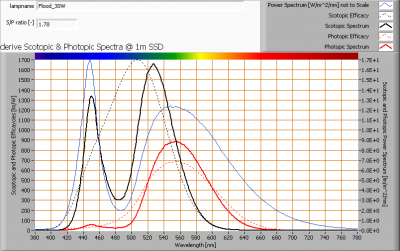
The power spectrum, sensitivity curves and resulting scotopic and photopic spectra (spectra energy content defined at 1 m distance).
The S/P ratio is 1.8.
More info on S/P ratio can be found on the OliNo website.
Chromaticity diagram
The chromaticity space and the position of the lamp’s color coordinates in it.
The light coming from this lamp is just inside the area designated with class A. This class A is an area that is defined for signal lamps, see also the OliNo website.
Its coordinates are x=0.3354 and y=0.3640.
Color Rendering Index (CRI) or also Ra
Herewith the image showing the CRI as well as how well different colors are represented (rendered). The higher the number, the better the resemblance with the color when a black body radiator would have been used (the sun, or an incandescent lamp). Practical information and also some critics about the CRI can be found on the OliNo website.
Each color has an index Rx, and the first 8 indexes (R1 .. R8) are averaged to compute the Ra which is equivalent to the CRI.
CRI of the light of this lightbulb.
The value of 67 is lower than 80 which is considered a minimum value for indoor usage.
Note: the chromaticity difference is 0.0070 indicates the distance to the Planckian Locus. There is no norm yet that states what the max deviation from white light is allowed to be. A reference with signal lights as a reference is given in the chromaticity diagram.
Voltage dependency
The dependency of a number of lamp parameters on the lamp voltage is not determined.
Warm up effects
After switch on of a cold lamp, the effect of heating up of the lamp is measured on illuminance E_v [lx], the lamppower P [W] and the luminous efficacy [lm/W].
Effect of warming up on different light bulb parameters. At top the 100 % level is put at begin, and at bottom at the end.
The warm up time is about 50 minutes. During that time the illuminance decreases with 7 % and the consumed power with almost 5 %.
Measure of flickering
An analysis is done on the measure of flickering of the light output by this light bulb. See the OliNo site for more information.
The measure of fast illuminance variartion of the light of the light bulb
| parameter | waarde | eenheid |
|---|---|---|
| Flicker frequency | n.a. | Hz |
| Illuminance modulation index | 0 | % |
The illuminance modulation index is computed as: (max_Ev – min_Ev) / (max_Ev + min_Ev).
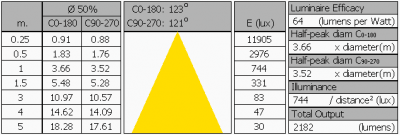
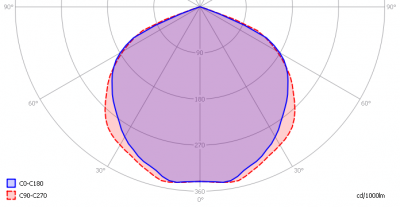
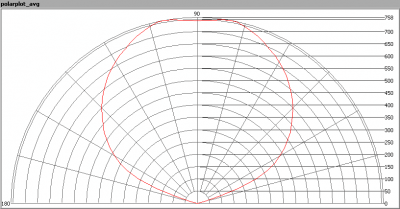
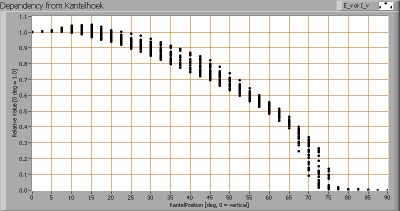
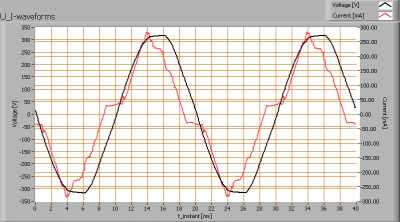
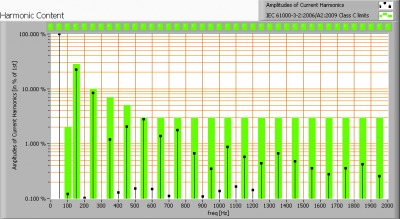
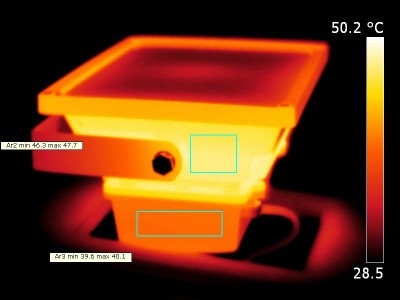


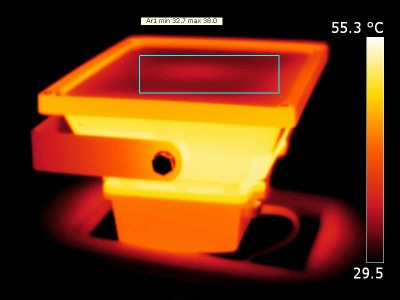
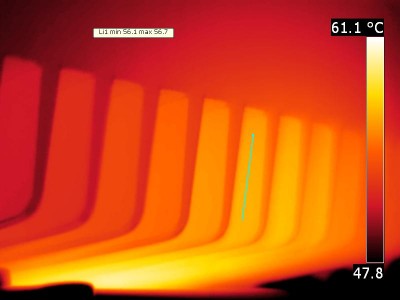
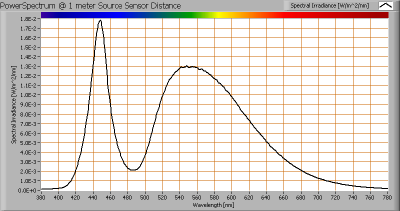
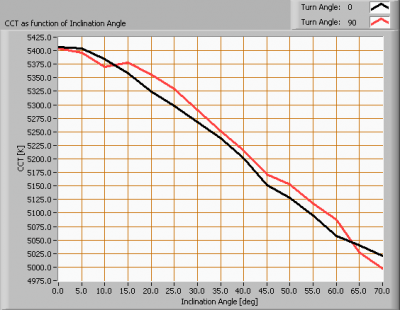
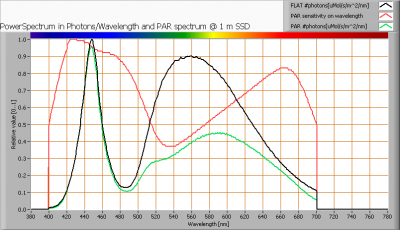
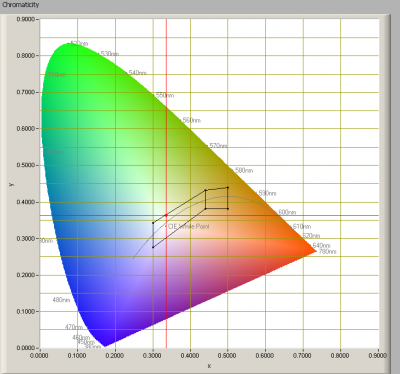
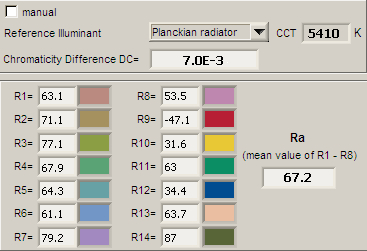
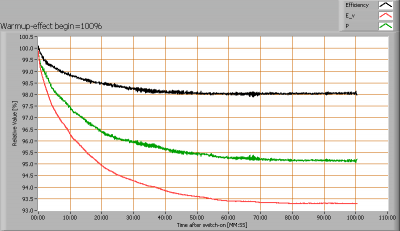
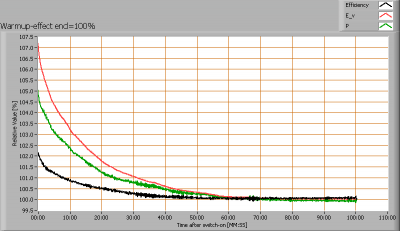
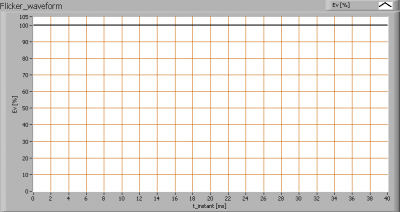
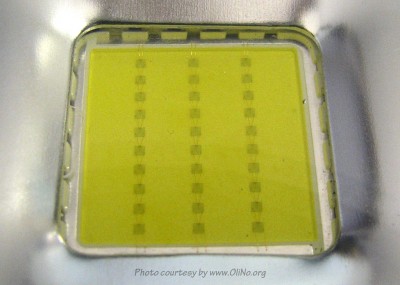



Most popular posts